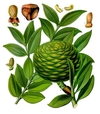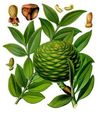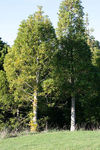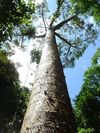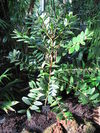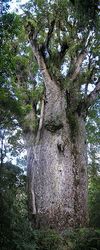Genus Agathis
The genus Agathis, commonly known as kauri or dammar, is a relatively small genus of 21 species of evergreen tree.Species in the genus Agathis of plants
Black kauri - The Black Kauri or Blue Kauri is a species of conifer in the Araucariaceae family. It is found only in Queensland, Australia. It is threatened by habitat loss.
New Zealand Kauri - Kauri forests are among the most ancient in the world. The antecedents of the kauri appeared during the Jurassic period . Although the kauri is among the most ancient trees in the world, it has developed a unique niche in the forest. With its novel soil interaction and regeneration pattern it can compete with the more recently evolved and faster growing angiosperms. Because it is such a conspicuous species, forest containing kauri is generally known as kauri forest, although kauri need not be the most abundant tree. In the warmer northern climate, kauri forests have a higher species richness than those found further south.
Agathis celebica - This tree is a source of dammar gum, also known as cat-eye resin.
Agathis corbassonii - It is a medium-sized to large evergreen tree growing to 40 m tall. The leaves are in decussate opposite pairs, 4.5-7 cm long and 6-11 mm broad. The cones are globose, 10 cm diameter, and disintegrate at maturity to release the winged seeds.
Dammar Kauri - This tree is a source of dammar gum, also known as cat-eye resin.
Agathis lanceolata - Agathis lanceolata is a species of conifer in the Araucariaceae family. It is found only in New Caledonia. It is threatened by habitat loss.
Fijian Kauri - Agathis macrophylla known as the Pacific Kauri, is a coniferous tree native to the islands of the southwestern Pacific Ocean in tropical humid lowlands and lower montane regions, notably in Fiji, Vanuatu, the Santa Cruz Islands, and the Solomon Islands. The Pacific Kauri is one of the largest and fastest growing species in its genus, and is important in forestry throughout the humid tropics.
Bull kauri - Bull Kauri grows to about 50 m in height and 2.7 m diameter. The trunk is unbuttressed, straight and with little taper. Distinctive features are coarse, flaky bark, medium-sized cones with 160-210 scales, and leaves with numerous lngitudinal, parallel veins.
Agathis moorei - It is a medium-sized evergreen tree growing up to 30 m tall. The leaves are in decussate opposite pairs, 5-7 cm long and 8-12 mm broad. The cones are oval, up to 15 cm long and 12 cm diameter, and disintegrate at maturity to release the winged seeds.
Kauri - It is a large coniferous evergreen tree growing up to 65m tall with smooth, grey coloured bark. The leaves are oval, 4-6 cm long and 1.5-2 cm broad on adult trees, slightly larger, up to 7 cm long and 3 cm broad, on young trees. The seed cones are squat ovoid, 7-9 cm long and 12 cm diameter, containing numerous spirally arranged scales 28-32 mm long and 35-45 mm broad, each scale bearing a single winged seed. The pollen cones are 25-45 mm long and 10-11 mm broad.
Queensland kauri - It is a large evergreen tree growing straight and tall to a height of 30-50 m, with smooth, scaly bark. The leaves are 5-12 cm long and 2-5 cm broad, tough and leathery in texture, with no midrib; they are arranged in opposite pairs on the stem. The seed cones are globose, 8-13 cm diameter, and mature in 18-20 months after pollination; they disintegrate at maturity to release the seeds. The male cones are cylindrical, 5-10 cm long and 1-1.5 cm thick.
New guinea kauri - It is a large evergreen tree growing up to 60 m tall. The leaves are in decussate opposite pairs, 7-10 cm long and 18-30 mm broad on mature trees, up to 13 cm long and 45 mm broad on young trees. The cones are oval, 8.5-10 cm long and 6.5-7.5 cm diameter, and disintegrate at maturity to release the winged seeds.


